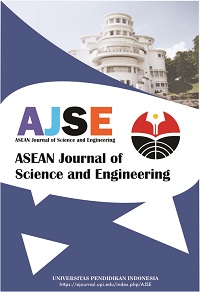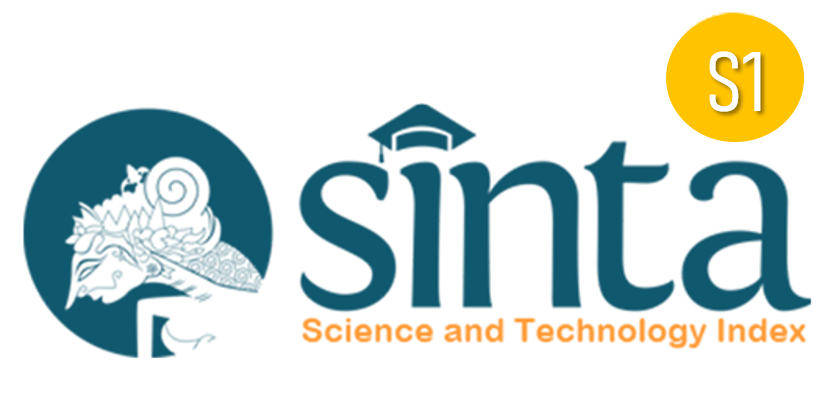Assessment and Optimization of Coagulation Process in Water Treatment Plant: A Review
Abstract
Keywords
Full Text:
PDFReferences
Aguilar, M. I., Sáez, J., Lloréns, M., Soler, A., Ortuño, J. F., Meseguer, V., and Fuentes, A. (2005). Improvement of coagulation–flocculation process using anionic polyacrylamide as coagulant aid. Chemosphere, 58(1), 47-56.
Alfaro, O. C., Martín Domínguez, A., Rigas, F., Solís-López, M., and Ramírez-Zamora, R. M. (2016). Optimization of the coagulation–flocculation process for the removal of natural organic matter fractions present in drinking water sources. Water Quality Research Journal of Canada, 51(2), 153-166.
Amran, A. H., Zaidi, N. S., Muda, K., and Loan, L. W. (2018). Effectiveness of natural coagulant in coagulation process: a review. International Journal of Engineering and Technology, 7(3.9), 34-37.
Barrows, A. P., Christiansen, K. S., Bode, E. T., and Hoellein, T. J. (2018). A watershed-scale, citizen science approach to quantifying microplastic concentration in a mixed land-use river. Water Research, 147, 382-392.
Baxter, C. W., Zhang, Q., Stanley, S. J., Shariff, R., Tupas, R. R., and Stark, H. L. (2001). Drinking water quality and treatment: the use of artificial neural networks. Canadian Journal of civil engineering, 28(S1), 26-35.
Bello, O., Hamam, Y., and Djouani, K. (2014). Coagulation process control in water treatment plants using multiple model predictive control. Alexandria Engineering Journal, 53(4), 939-948.
Bello, O., Hamam, Y., and Djouani, K. (2014). Control of a coagulation chemical dosing unit for water treatment plants using MMPC based on fuzzy weighting. Journal of Water Process Engineering, 4, 34-46.
Bello, O., Hamam, Y., and Djouani, K. (2014). Nonlinear model predictive control of a coagulation chemical dosing unit for water treatment plants. IFAC Proceedings Volumes, 47(3), 370-376.
Bello, O., Hamam, Y., and Djouani, K. (2016). A Survey of Modelling Techniques and Control Strategies Employed for Coagulation Process in Drinking Water Treatment Plants. International Journal of Engineering Research and Technology, 5(2), 229-236.
Bolto, B., and Gregory, J. (2007). Organic polyelectrolytes in water treatment. Water Research, 41(11), 2301-2324.
Chao, H. J., Zhang, X., Wang, W., Li, D., Ren, Y., Kang, J., and Liu, D. (2020). Evaluation of carboxymethylpullulan‐AlCl3 as a coagulant for water treatment: A case study with kaolin. Water Environment Research, 92(2), 302-309.
Chen, C. L., and Hou, P. L. (2006). Fuzzy model identification and control system design for coagulation chemical dosing of potable water. Water Science and Technology: Water Supply, 6(3), 97-104.
Chow, C. W., van Leeuwen, J. A., Fabris, R., and Drikas, M. (2009). Optimised coagulation using aluminium sulfate for the removal of dissolved organic carbon. Desalination, 245(1-3), 120-134.
Cui, H., Huang, X., Yu, Z., Chen, P., and Cao, X. (2020). Application progress of enhanced coagulation in water treatment. RSC Advances, 10(34), 20231-20244.
Dentel, S. K. (1991). Coagulant control in water treatment. Critical Reviews in Environmental Science and Technology, 21(1), 41-135.
Devrimci, H. A., Yuksel, A. M., and Sanin, F. D. (2012). Algal alginate: A potential coagulant for drinking water treatment. Desalination, 299, 16-21.
dos Santos, F. C. R., Librantz, A. F. H., Dias, C. G., and Rodrigues, S. G. (2017). < b> Intelligent system for improving dosage control. Acta Scientiarum. Technology, 39(1), 33-38.
Driscoll, C. T., and Letterman, R. D. (1995). Factors regulating residual aluminium concentrations in treated waters. Environmetrics, 6(3), 287-305.
Fabris, R., Chow, C., Dexter, R., Colton, J., Knoblauch, J., and Drikas, M. (2013). Feed-forward coagulant control using online UV/Vis monitoring. Water Science and Technology: Water Supply, 13(2), 420-426.
Farhaoui, M., and Derraz, M. (2016). Review on optimization of drinking water treatment process. Journal of Water Resource and Protection, 8(8), 777-786.
Gagnon, C., Grandjean, B. P., and Thibault, J. (1997). Modelling of coagulant dosage in a water treatment plant. Artificial Intelligence in Engineering, 11(4), 401-404.
Ghernaout, D., and Ghernaout, B. (2012). Sweep flocculation as a second form of charge neutralisation—a review. Desalination and Water Treatment, 44(1-3), 15-28.
Ghernaout, D., Elboughdiri, N., Ghareba, S., and Salih, A. (2020). Coagulation Process for Removing Algae and Algal Organic Matter—An Overview. Open Access Library Journal, 7(4), 1-21.
Herman, L. D. (1983). Principles of Coagulation and Flocculation. Opflow, 9(10), 3-3.
Hu, C., Liu, H., Qu, J., Wang, D., and Ru, J. (2006). Coagulation behavior of aluminum salts in eutrophic water: significance of Al13 species and pH control. Environmental science and technology, 40(1), 325-331.
Hussain, S., Awad, J., Sarkar, B., Chow, C. W., Duan, J., and van Leeuwen, J. (2019). Coagulation of dissolved organic matter in surface water by novel titanium (III) chloride: mechanistic surface chemical and spectroscopic characterisation. Separation and Purification Technology, 213, 213-223.
Hussein, M., Alalm, M. G., and Eletriby, H. (2018). Removal of Natural Organic Matter and Turbidity in Drinking Water by Modified Flaxseed Husk. International Journal of Environmental Sciences and Natural Resources, 11(2), 49-52.
Ivančev-Tumbas, I. (2014). The fate and importance of organics in drinking water treatment: a review. Environmental Science and Pollution Research, 21(20), 11794-11810.
Jiang, J. Q. (2001). Development of coagulation theory and pre-polymerized coagulants for water treatment. Separation and Purification Methods, 30(1), 127-141.
Joo, D. S., Choi, D. J., and Park, H. (2000). Determination of optimal coagulant dosing rate using an artificial neural network. Journal of Water Supply: Research and Technology—AQUA, 49(1), 49-55.
Kim, S. G., Choi, K. J., Son, H. J., Jun, Y. C., Rhee, J. B., Shon, I. S., ... and Kim, S. H. (2006). Monitoring of coagulation performance and determination of coagulant dosage using a pilot in-line filter. Water Science and Technology, 53(4-5), 411-417.
Krupińska, I. (2020). Aluminium drinking water treatment residuals and their toxic impact on human health. Molecules, 25(3), 641.
Kurniawan, S. B., Abdullah, S. R. S., Imron, M. F., Said, N. S. M., Ismail, N. I., Hasan, H. A., ... and Purwanti, I. F. (2020). Challenges and opportunities of biocoagulant/bioflocculant application for drinking water and wastewater treatment and its potential for sludge recovery. International Journal of Environmental Research and Public Health, 17(24), 9312.
Lambert, A. O., Brown, T. G., Takizawa, M., and Weimer, D. (1999). A review of performance indicators for real losses from water supply systems. Journal of Water Supply: Research and Technology—AQUA, 48(6), 227-237.
Lee, S. J., Lee, Y. J., and Nam, S. H. (2008). Improvement in the coagulation performance by combining Al and Fe coagulants in water purification. Korean Journal of Chemical Engineering, 25(3), 505-512.
León-Luque, A. J., Barajas, C. L., and Peña-Guzmán, C. A. (2016). Determination of the optimal dosage of aluminum sulfate in the coagulation-flocculation process using an artificial neural network. International Journal of Environmental Science and Development, 7(5), 346.
Liu, W., and Ratnaweera, H. (2016). Improvement of multi-parameter-based feed-forward coagulant dosing control systems with feed-back functionalities. Water Science and Technology, 74(2), 491-499.
Loganathan, P., Gradzielski, M., Bustamante, H., and Vigneswaran, S. (2020). Progress, challenges, and opportunities in enhancing NOM flocculation using chemically modified chitosan: A review towards future development. Environmental Science: Water Research and Technology, 6(1), 45-61.
Maier, H. R., Morgan, N., and Chow, C. W. (2004). Use of artificial neural networks for predicting optimal alum doses and treated water quality parameters. Environmental Modelling and Software, 19(5), 485-494.
Matilainen, A., Vepsäläinen, M., and Sillanpää, M. (2010). Natural organic matter removal by coagulation during drinking water treatment: A review. Advances in Colloid and Interface Science, 159(2), 189-197.
Mustereț, C. P., Morosanu, I., Ciobanu, R., Plavan, O., Gherghel, A., Al-Refai, M., ... and Teodosiu, C. (2021). Assessment of Coagulation–Flocculation Process Efficiency for the Natural Organic Matter Removal in Drinking Water Treatment. Water, 13(21), 3073.
Nowacka, A., Włodarczyk-Makuła, M., and Macherzyński, B. (2014). Comparison of effectiveness of coagulation with aluminum sulfate and pre-hydrolyzed aluminum coagulants. Desalination and Water Treatment, 52(19-21), 3843-3851.
Pernitsky, D. J., and Edzwald, J. K. (2006). Selection of alum and polyaluminum coagulants: principles and applications. Journal of Water Supply: Research and Technology—AQUA, 55(2), 121-141.
Ratnaweera, H., and Fettig, J. (2015). State of the art of online monitoring and control of the coagulation process. Water, 7(11), 6574-6597.
Saritha, V., Srinivas, N., and Srikanth Vuppala, N. V. (2017). Analysis and optimization of coagulation and flocculation process. Applied Water Science, 7(1), 451-460.
Saxena, K., Brighu, U., and Choudhary, A. (2019). Coagulation of humic acid and kaolin at alkaline pH: Complex mechanisms and effect of fluctuating organics and turbidity. Journal of Water Process Engineering, 31, 100875.
Setareh, P., Pirsaheb, M., Khezri, S. M., and Hossaini, H. (2021). Improving natural organic matter and turbidity removal from surface water by pre-coagulation combined with ozone/ultrasound. Water Supply, 21(4), 1410-1422.
Sibiya, S. M. (2014). Evaluation of the streaming current detector (SCD) for coagulation control. Procedia Engineering, 70, 1211-1220.
Staaks, C., Fabris, R., Lowe, T., Chow, C. W., van Leeuwen, J. A., and Drikas, M. (2011). Coagulation assessment and optimisation with a photometric dispersion analyser and organic characterisation for natural organic matter removal performance. Chemical Engineering Journal, 168(2), 629-634.
Trinh, T. K., and Kang, L. S. (2011). Response surface methodological approach to optimize the coagulation–flocculation process in drinking water treatment. Chemical Engineering Research and Design, 89(7), 1126-1135.
Tzoupanos, N. D., and Zouboulis, A. I. (2010). Novel inorganic-organic composite coagulants based on aluminium. Desalination and Water Treatment, 13(1-3), 340-347.
Usefi, S., and Asadi-Ghalhari, M. (2019). Modeling and optimization of the coagulation–flocculation process in turbidity removal from aqueous solutions using rice starch. Pollution, 5(3), 623-636.
Van Leeuwen, J., Chow, C. W. K., Bursill, D., and Drikas, M. (1999). Empirical mathematical models and artificial neural networks for the determination of alum doses for treatment of southern Australian surface waters. Journal of Water Supply: Research and Technology—AQUA, 48(3), 115-127.
Varjani, S. J., Gnansounou, E., and Pandey, A. (2017). Comprehensive review on toxicity of persistent organic pollutants from petroleum refinery waste and their degradation by microorganisms. Chemosphere, 188, 280-291.
Vrečko, D., Hvala, N., and Carlsson, B. (2003). Feedforward-feedback control of an activated sludge process: a simulation study. Water Science and Technology, 47(12), 19-26.
Wu, G. D., and Lo, S. L. (2008). Predicting real-time coagulant dosage in water treatment by artificial neural networks and adaptive network-based fuzzy inference system. Engineering Applications of Artificial Intelligence, 21(8), 1189-1195.
Wu, Z., Zhang, X., Pang, J., Zhang, X., Li, J., Li, J., and Zhang, P. (2020). Humic acid removal from water with PAC-Al30: effect of calcium and kaolin and the action mechanisms. ACS Omega, 5(27), 16413-16420.
Xie, P., Chen, Y., Ma, J., Zhang, X., Zou, J., and Wang, Z. (2016). A mini review of preoxidation to improve coagulation. Chemosphere, 155, 550-563.
Zhang, Q., and Stanley, S. J. (1999). Real-time water treatment process control with artificial neural networks. Journal of Environmental Engineering, 125(2), 153-160.
DOI: https://doi.org/10.17509/ajse.v3i1.45035
Refbacks
- There are currently no refbacks.
Copyright (c) 2022 Universitas Pendidikan Indonesia

This work is licensed under a Creative Commons Attribution-ShareAlike 4.0 International License.












